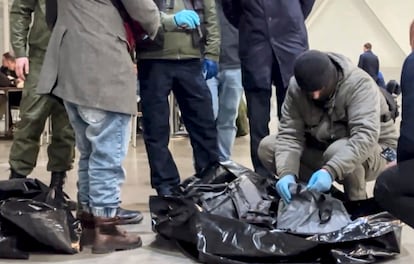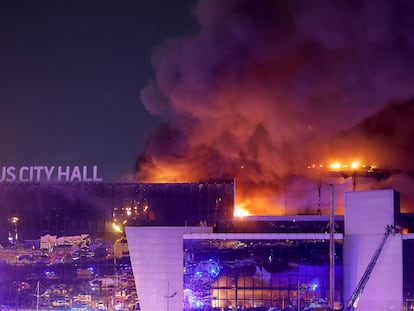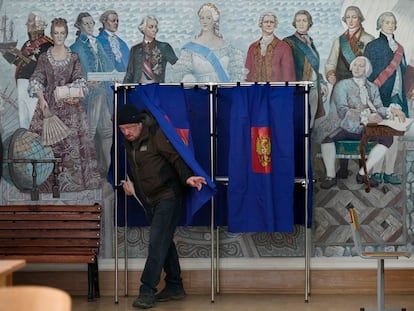What we know about the attack at Moscow’s Crocus City Hall
Russian intelligence services have detained 11 suspects linked to Russia’s worst terrorist attack in two decades

A terrorist attack at the concert venue Crocus City Hall, located northwest of Moscow, on Friday killed at least 130 people and wounded more than a hundred, according to the Russian Investigative Committee, a prosecuting body that reports to the presidency. It is the worst attack in Russia in two decades. At this time, there is no official confirmation on the authorship of the attack, although the Islamic State took responsibility for it on its Telegram channel, according to Reuters. This Saturday, the arrest of 11 suspects was reported, four of them accused of direct involvement in the attack. The following are the details known so far:
The place of the attack: a concert hall
Crocus City Hall is located in the city of Krasnogorsk, 15 miles northwest of Moscow. A group of people dressed in camouflage entered the concert hall with assault weapons and opened fire just before the start of the band Picnic’s performance at 20.00 on Friday. The 6,200 tickets available for the event were sold out and videos from the venue show the point-blank shooting of some attendees as they tried to flee.
Other victims
The attackers also set fire to the leisure center housing the concert hall, where a series of children’s contests were being held with children from the Vologda region, located 300 miles north of Moscow. The Russian press reported that numerous people, including children, were trapped in the burning part of the building.
Less than 20 minutes
It all happened in just 18 minutes. According to a chronology by the Russian channel Shot, a white Renault stopped in front of the entrance of the concert hall at 19.55 Moscow time, as the band Picnic was scheduled to start playing five minutes later. The terrorists got out of the vehicle with assault weapons and opened fire on the guards and other people present at the building’s reception. According to Shot, at 20.03 they arrived at the auditorium and fired at the spectators. They also set the place on fire with several containers of gasoline they were carrying. Finally, the white Renault Simbol with four terrorists inside left the parking lot of the Crocus hall at 20.13.
Who is behind the attack
There is no official confirmation of responsibility. Russian media point to citizens of Tajikistan as suspects. A branch of the Islamic State (ISIS) claimed responsibility for the attack on Friday night. The United States and the United Kingdom issued a warning of possible terrorist attacks in Russia two weeks ago, shortly after Russian intelligence services announced that they had foiled an Islamic State attack on a synagogue in the Russian capital. Washington stressed in its warning the risk of attacks on “events with many people, such as concerts”. Russian President Vladimir Putin downplayed the threat and said: “All this looks like outright blackmail with the intention of intimidating and destabilizing our society”.
Does Ukraine have anything to do with it?
In the aftermath of the attack, some accusing fingers were pointed at Ukraine as a country with motives to attack in Moscow, but Washington said there is no indication that Kyiv is behind the terrorist attack. Before the Islamic State’s claim was known, Kyiv had denied being responsible for the massacre. Mikhail Podoliak, advisor to Ukrainian President Volodymyr Zelenskiy, categorically rejected any connection with the attack. “Ukraine has absolutely and definitely nothing to do with the event. We have an intense and huge full-scale war with the Russian army and with the Russian Federation. And, in spite of everything, everything will be decided precisely on the Ukrainian battlefield,” Podoliak stressed, adding that the Ukrainian authorities do not use terrorist methods.
Who has been detained
Among those reported arrested on Saturday were four alleged attackers, Russian news agency Tass informed. At least five of the 11 suspects would be citizens of Tajikistan, according to information published by Baza, Shot and Ostorodzhno media, Novosti and a deputy of the State Duma, which have revealed the identities, including photos, of the suspects. According to leaked information, the car of the alleged attackers has been intercepted in the Bryansk region, 400 kilometers southwest of Moscow, near the border with Belarus.
Five attackers have been identified as citizens of Tajikistan who fled the Crocus hall in the Renault Simbol: Muhammadsobir Fayzov (19 years old, from Dushanbe, the capital of Tajikistan, injured and arrested in his escape attempt), Shokhinjonn Safolzoda (21 years old), Rustam Nazarov (29 years old), Majmadrasul Nasridinov (37 years old) and Rivozhidin Ismonov (51 years old). In addition, they were registered as residents of the Russian regions of Yaroslavl, Ivanovo and Samara. One more alleged terrorist fled with them, but has not been identified, according to preliminary information.
What relationship does Tajikistan have with Russia?
Tajikistan, bordering Afghanistan, is one of the hot spots of Islamic terrorism in the post-Soviet space. The Kremlin supports the Dushanbe authorities militarily to control extremist groups crossing that porous border, and the risk of attacks is a concern that often comes up at meetings of the Collective Security Treaty Organization (CSTO), Russia’s alternative to NATO. Moreover, Russia has become a major target of ISIS because of its support for both the government of Bashar el-Assad in Syria and the Taliban movement in Afghanistan, a traditional ally of another extremist faction that is an enemy of ISIS, al-Qaeda. Tajikistan has sent its condolences to Russia.
The worst attack in two decades
Russia has a long history of terrorist attacks, which rocked the country after the collapse of the Soviet Union and during the first years of Vladimir Putin’s rule. Most of them were part of the two bloody separatist wars in Chechnya, which the Russian leader crushed with an iron fist. The terrible images of the venue, where thousands of people were waiting to attend a concert, recall those of the attack on the Dubrovka theater in the Russian capital in 2002, when a group of Chechen militants staged a gigantic hostage crisis. The operation by Russian security forces to free the theater, using an anesthetic gas, resulted in 130 deaths.
In 2004, two years after the Dubrovka street theater tragedy, a group of Chechen terrorists took 1,200 hostages in a school in the city of Beslan. 334 people died, including 186 children. The most recent attack occurred in 2017, in the St. Petersburg metro, where 15 people were killed. Russian authorities linked the attackers to an Islamist group. In 2015, a Russian airliner exploded over Egypt’s Sinai desert with 224 people on board, most of them Russian citizens, in an attack that was claimed by the self-declared Islamic State.
Sign up for our weekly newsletter to get more English-language news coverage from EL PAÍS USA Edition
Tu suscripción se está usando en otro dispositivo
¿Quieres añadir otro usuario a tu suscripción?
Si continúas leyendo en este dispositivo, no se podrá leer en el otro.
FlechaTu suscripción se está usando en otro dispositivo y solo puedes acceder a EL PAÍS desde un dispositivo a la vez.
Si quieres compartir tu cuenta, cambia tu suscripción a la modalidad Premium, así podrás añadir otro usuario. Cada uno accederá con su propia cuenta de email, lo que os permitirá personalizar vuestra experiencia en EL PAÍS.
¿Tienes una suscripción de empresa? Accede aquí para contratar más cuentas.
En el caso de no saber quién está usando tu cuenta, te recomendamos cambiar tu contraseña aquí.
Si decides continuar compartiendo tu cuenta, este mensaje se mostrará en tu dispositivo y en el de la otra persona que está usando tu cuenta de forma indefinida, afectando a tu experiencia de lectura. Puedes consultar aquí los términos y condiciones de la suscripción digital.
More information
Archived In
Últimas noticias
Maduro pleads not guilty before the federal court in New York: ‘I am still the president of Venezuela’
A new test can detect Alzheimer’s from a finger prick
UN team enters Sudanese city of El Fasher after paramilitary massacre: ‘It’s like a ghost town’
A recipe for resistance: Indigenous peoples politicize their struggles from the kitchen
Most viewed
- Gilles Lipovetsky: ‘If you want to live better and fall in love, take Prozac, don’t look to philosophy’
- Alain Aspect, Nobel laureate in physics: ‘Einstein was so smart that he would have had to recognize quantum entanglement’
- Maduro’s downfall puts China’s relationship with Venezuela to the test
- Why oil has been at the center of Venezuela-US conflicts for decades
- Alvin Hellerstein, a 92-year-old judge appointed by Bill Clinton, to preside over Maduro’s trial in New York











































